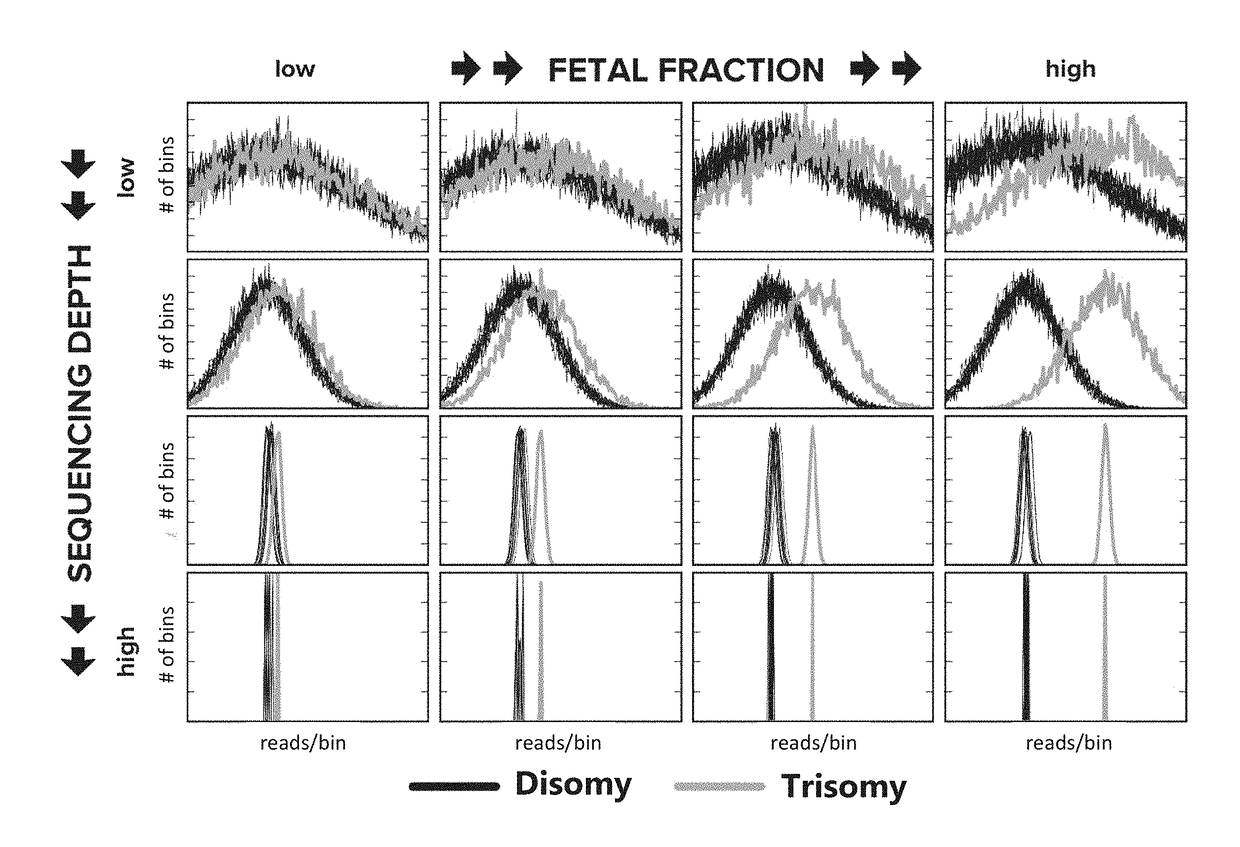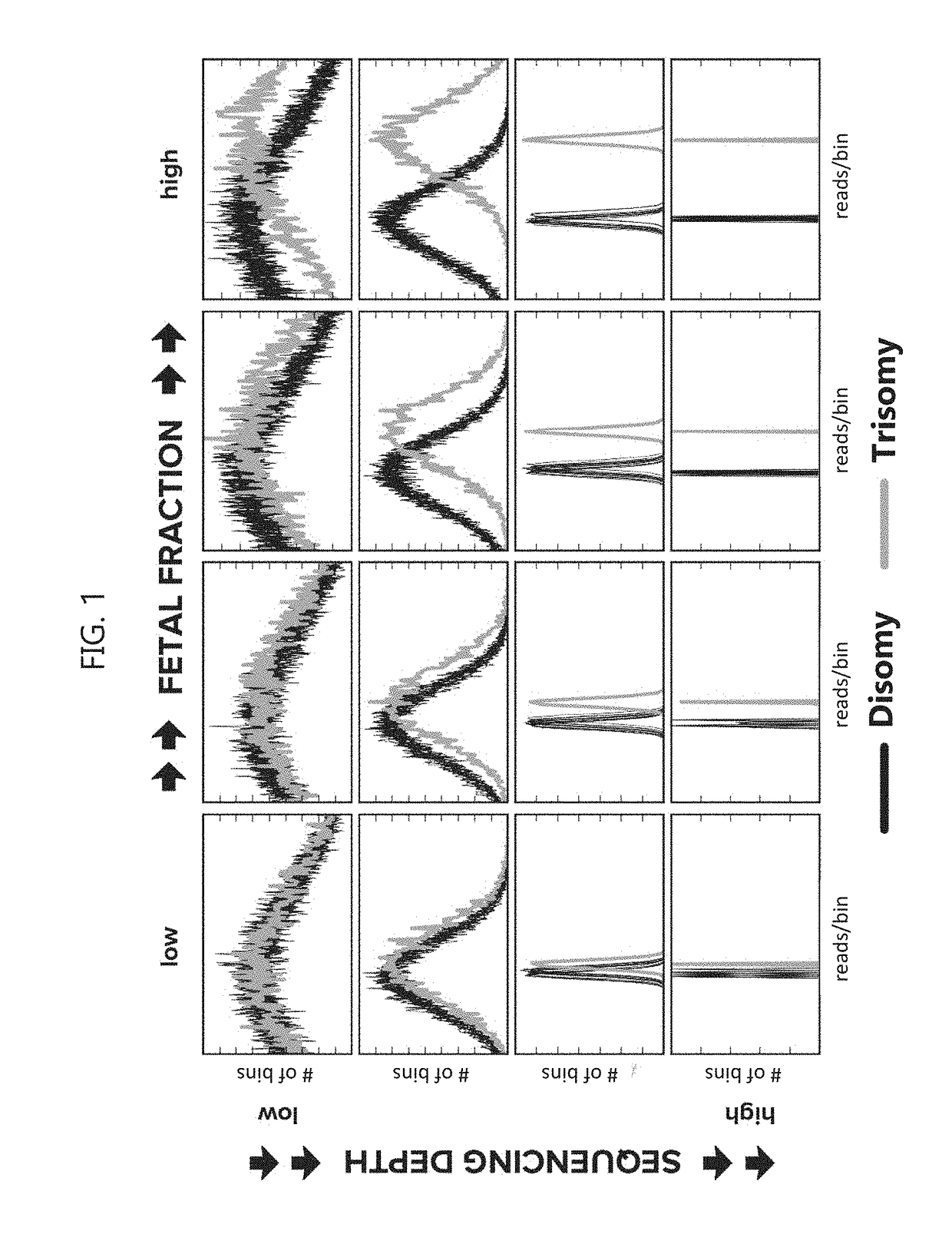Noninvasive prenatal screening using dynamic iterative depth optimization
- Summary
- Abstract
- Description
- Claims
- Application Information
AI Technical Summary
Benefits of technology
Problems solved by technology
Method used
Image
Examples
example 1
Fetal Fraction Determination
[0292]Cell-free DNA of 1249 maternal samples taken from women with male pregnancies was sequenced by massively parallel sequencing. For each maternal sample, the sequencing reads from each chromosome were aligned using a reference genome, binned in a plurality of bins, and the number of sequencing reads in each bin were counted. The bins were each 20 kilobases in length, giving approximately 155,000 bins across the genome. The counted reads were normalized to account for GC correction, bin mappability, and median scaling. For median scaling, the count in each bin in any given sample was divided by the median value across all bins in that sample, thus making the bin counts centered at 1.0, or a log 2 value centered at 0. At least 15e6 genome-wide sequencing reads were obtained for each maternal sample, with the average number of reads being about 17e6 genome-wide sequencing reads.
[0293]The measured fetal fraction, FFo, for each maternal sample was determin...
example 2
Fetal Fraction Determination with Low Sequencing Depth
[0299]Fetal fraction was measured using the trained linear regression model (trained using the 1249 training samples, as described in Example 1) for 180 low sequencing depth samples (sequencing depth was between 8e6 and 12e6 reads across the whole genome), and normalized using the percentiles of the regression fetal fractions. The observed fetal fraction was determined using the median reads per bin from the X chromosome and the median reads per bin from the Y chromosome, as described above. Measured fetal fractions of the 180 maternal samples were plotted against the observed fetal fractions, with a correlation coefficient of 0.882, excluding two outliers. See FIG. 8. For the outlier marked with an asterisk (*) in FIG. 8, the fetus was likely monosomy X, with only residual chromosome Y signal, causing an incorrect fetal fraction determination using binned sequencing reads from both the X chromosome and the Y chromosome. The meas...
example 3
Fetal Aneuploidy Determination
[0300]To elucidate the relationship between sensitivity and sequencing depth, mock samples at arbitrary fetal fraction and read depth were constructed by mixing empirical sequencing data in silico. Maternal samples with fetal cfDNA that are trisomic for chromosome 13 (n=5), trisomic for chromosome 18 (n=3), trisomic for chromosome 21 (n=6), or monosomic for chromosome X (n=4), each with a known fetal fraction determined using sequencing read density (reads per bin) from the Y chromosome and X chromosome (fetal fraction for those pregnancies with monosomy chromosome X was determined using only the X chromosome), or samples from non-pregnant women (n=5) were sequenced using massively parallel sequencing at a whole-genome read depth of about 100 million reads. The reads from each sample were split into ˜200 slices of 500,000 reads, and 245,000 simulated maternal samples were generated by randomly blending read slices from aneuploid samples and non-pregnant...
PUM
| Property | Measurement | Unit |
|---|---|---|
| Fraction | aaaaa | aaaaa |
| Fraction | aaaaa | aaaaa |
| Fraction | aaaaa | aaaaa |
Abstract
Description
Claims
Application Information
 Login to View More
Login to View More - R&D
- Intellectual Property
- Life Sciences
- Materials
- Tech Scout
- Unparalleled Data Quality
- Higher Quality Content
- 60% Fewer Hallucinations
Browse by: Latest US Patents, China's latest patents, Technical Efficacy Thesaurus, Application Domain, Technology Topic, Popular Technical Reports.
© 2025 PatSnap. All rights reserved.Legal|Privacy policy|Modern Slavery Act Transparency Statement|Sitemap|About US| Contact US: help@patsnap.com



